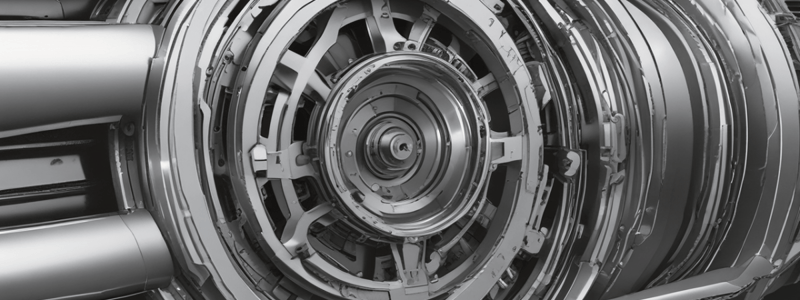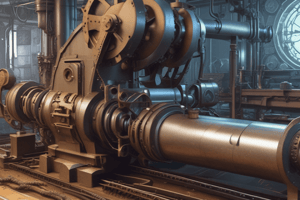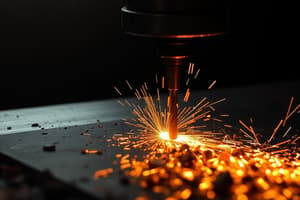Podcast
Questions and Answers
What is the purpose of machining as explained in the text?
What is the purpose of machining as explained in the text?
- To create metal components with irregular shapes
- To apply heat treatment to the metal components
- To remove excess material and achieve desired dimensions and surface finish (correct)
- To increase the weight of the metal components
Which classification of metal working processes involves turning, drilling, and milling?
Which classification of metal working processes involves turning, drilling, and milling?
- Cutting shaping or metal cutting process (correct)
- Forging process
- Metal forming process
- Non-cutting shaping or chips less process
How are engineering components like gears and bearings typically finished for accuracy and good surface finish?
How are engineering components like gears and bearings typically finished for accuracy and good surface finish?
- Through casting and forging
- By machining and grinding (correct)
- By preforming blanks
- By applying heat treatment
What is the key function of cutting tools in the machining process?
What is the key function of cutting tools in the machining process?
Why do preformed parts called blanks need semi-finishing and finishing according to the text?
Why do preformed parts called blanks need semi-finishing and finishing according to the text?
What distinguishes metal cutting or chip forming processes like turning from non-cutting shaping processes like forging?
What distinguishes metal cutting or chip forming processes like turning from non-cutting shaping processes like forging?
What type of cutting tools involve more than two major cutting edges?
What type of cutting tools involve more than two major cutting edges?
What is the main purpose of providing a positive rake angle in cutting tools?
What is the main purpose of providing a positive rake angle in cutting tools?
In metal cutting operations, what does the clearance angle help to avoid?
In metal cutting operations, what does the clearance angle help to avoid?
Which system of tool description involves providing quantitative information about the angles?
Which system of tool description involves providing quantitative information about the angles?
What does the term 'ORS' stand for in tool geometry?
What does the term 'ORS' stand for in tool geometry?
Which type of cutting tool has a positive clearance angle between 30 and 150 degrees?
Which type of cutting tool has a positive clearance angle between 30 and 150 degrees?
What role does the rake angle play in metal cutting?
What role does the rake angle play in metal cutting?
'ASA' system in tool geometry stands for which of the following?
'ASA' system in tool geometry stands for which of the following?
'WRS' is associated with which system of describing tool geometry?
'WRS' is associated with which system of describing tool geometry?
'NRS' is a part of which system of tool description?
'NRS' is a part of which system of tool description?
What is the main function of a machine tool in machining?
What is the main function of a machine tool in machining?
How are machine tools broadly classified based on size?
How are machine tools broadly classified based on size?
What is the purpose of a cutting fluid in machining?
What is the purpose of a cutting fluid in machining?
Which type of machine tool is used for mass production?
Which type of machine tool is used for mass production?
What is the classification of machine tools according to automation levels?
What is the classification of machine tools according to automation levels?
Which type of machine tool is typically used for heavy-duty tasks like boring mills?
Which type of machine tool is typically used for heavy-duty tasks like boring mills?
What are the basic functions of a machine tool in machining?
What are the basic functions of a machine tool in machining?
'Ordinary' and 'high precision' are classifications under which category related to machine tools?
'Ordinary' and 'high precision' are classifications under which category related to machine tools?
'Single spindle' and 'multi spindle' are classifications under which category related to machine tools?
'Single spindle' and 'multi spindle' are classifications under which category related to machine tools?
Which type of automation is associated with CNC milling machines?
Which type of automation is associated with CNC milling machines?
What is meant by chip flow deviation angle in machining?
What is meant by chip flow deviation angle in machining?
In pure orthogonal cutting, what are the values of the angles a and f?
In pure orthogonal cutting, what are the values of the angles a and f?
What is the main index of machining that is indicated directly or indirectly by the form of machined chips?
What is the main index of machining that is indicated directly or indirectly by the form of machined chips?
What mainly determines the form of machined chips?
What mainly determines the form of machined chips?
In machining ductile materials, what happens when shear stress exceeds the shear strength of the work material in the deformation region?
In machining ductile materials, what happens when shear stress exceeds the shear strength of the work material in the deformation region?
What is responsible for causing shear stresses in the region of the chip during machining ductile materials?
What is responsible for causing shear stresses in the region of the chip during machining ductile materials?
How does slip or shear propagation stop during chip formation in machining ductile materials?
How does slip or shear propagation stop during chip formation in machining ductile materials?
What does the Piispannen model of card analogy aim to explain in machining ductile materials?
What does the Piispannen model of card analogy aim to explain in machining ductile materials?
What characteristic of chips helps understand nature and behavior of work material under machining conditions?
What characteristic of chips helps understand nature and behavior of work material under machining conditions?
What mainly determines the nature and degree of interactions at the chip-tool interfaces?
What mainly determines the nature and degree of interactions at the chip-tool interfaces?
What is the surface against which the chip slides upward on a single point tool?
What is the surface against which the chip slides upward on a single point tool?
In the ASA system, what is the angle of inclination of the principal flank from the machined surface and measured on the machine's longitudinal plane (X plane)?
In the ASA system, what is the angle of inclination of the principal flank from the machined surface and measured on the machine's longitudinal plane (X plane)?
Which angle provides strengthening of the tool nose and better surface finish?
Which angle provides strengthening of the tool nose and better surface finish?
In metal cutting processes, what is characteristic of orthogonal cutting?
In metal cutting processes, what is characteristic of orthogonal cutting?
What is the role of an inclination angle in the direction of chip flow according to Fig. 1.8?
What is the role of an inclination angle in the direction of chip flow according to Fig. 1.8?
Which plane in metal cutting contains the principal cutting edge?
Which plane in metal cutting contains the principal cutting edge?
What does the auxiliary flank in a single point cutting tool refer to?
What does the auxiliary flank in a single point cutting tool refer to?
"Face" on a single point tool is defined as:
"Face" on a single point tool is defined as:
"Base" of a single point tool refers to:
"Base" of a single point tool refers to:
In ASA system, what is ax related to?
In ASA system, what is ax related to?
What material property favors the formation of discontinuous chips?
What material property favors the formation of discontinuous chips?
What are the two basic mechanisms involved in chip formation during machining?
What are the two basic mechanisms involved in chip formation during machining?
How is the final deformation primarily accomplished in machining ductile materials?
How is the final deformation primarily accomplished in machining ductile materials?
Which type of chip formation process consumes lesser power and results in metal being fractured into segments?
Which type of chip formation process consumes lesser power and results in metal being fractured into segments?
What factor contributes to the formation of continuous chips without Built-Up Edge (BUE) chips?
What factor contributes to the formation of continuous chips without Built-Up Edge (BUE) chips?
What is the major reason that chip thickness (a2) becomes larger than the uncut chip thickness (a1) in machining?
What is the major reason that chip thickness (a2) becomes larger than the uncut chip thickness (a1) in machining?
Which method is NOT suggested as a feasible experimental method to study the deformation of machining chips?
Which method is NOT suggested as a feasible experimental method to study the deformation of machining chips?
In metal cutting, what role does cutting fluid play in chip formation?
In metal cutting, what role does cutting fluid play in chip formation?
What condition is favorable for producing continuous chips during metal cutting?
What condition is favorable for producing continuous chips during metal cutting?
Why does yielding occur at the crack-tip for ductile materials during machining?
Why does yielding occur at the crack-tip for ductile materials during machining?
What causes total separation of chips from the parent workpiece in machining brittle materials?
What causes total separation of chips from the parent workpiece in machining brittle materials?
Which type of chip formation is associated with shearing the metal and requires a positive and large rake angle?
Which type of chip formation is associated with shearing the metal and requires a positive and large rake angle?
What geometrical parameter represents the depth of cut during machining?
What geometrical parameter represents the depth of cut during machining?
In machining, what happens to the width of the chip after the cut compared to before the cut?
In machining, what happens to the width of the chip after the cut compared to before the cut?
'Chip reduction coefficient' or 'cutting ratio' is quantitatively assessed to understand which aspect of machining?
'Chip reduction coefficient' or 'cutting ratio' is quantitatively assessed to understand which aspect of machining?
What is the primary factor that determines the pattern and extent of total deformation in machining chips?
What is the primary factor that determines the pattern and extent of total deformation in machining chips?
What does a larger value of chip reduction coefficient, rc, indicate?
What does a larger value of chip reduction coefficient, rc, indicate?
How is chip thickening often expressed in relation to the reciprocal of rc?
How is chip thickening often expressed in relation to the reciprocal of rc?
What plays a significant role in reducing the value of rc according to equation 1.4?
What plays a significant role in reducing the value of rc according to equation 1.4?
What is the shear angle dependent on?
What is the shear angle dependent on?
What does a decrease in shear angle indicate about machining conditions?
What does a decrease in shear angle indicate about machining conditions?
How can cutting strain be defined in machining processes?
How can cutting strain be defined in machining processes?
In equation 1.3, what does 'r' represent?
In equation 1.3, what does 'r' represent?
According to equation 1.8, how does Vf compare to VC?
According to equation 1.8, how does Vf compare to VC?
'Shear angle increases both directly and indirectly with what factor?'
'Shear angle increases both directly and indirectly with what factor?'
What is the main cause of Built-up-Edge (BUE) formation in machining ductile metals?
What is the main cause of Built-up-Edge (BUE) formation in machining ductile metals?
How does the force, F, relate to the Built-up-Edge (BUE) formation?
How does the force, F, relate to the Built-up-Edge (BUE) formation?
What factor influences the shape, size, and bond strength of Built-up-Edges (BUE) formed during machining?
What factor influences the shape, size, and bond strength of Built-up-Edges (BUE) formed during machining?
What harmful effect does the formation of Built-up-Edges (BUE) have on cutting forces and power consumption?
What harmful effect does the formation of Built-up-Edges (BUE) have on cutting forces and power consumption?
In the context of machining, what does excessive cutting temperature due to high cutting velocity favor?
In the context of machining, what does excessive cutting temperature due to high cutting velocity favor?
Why does the workpiece experience plastic deformation during machining to produce continuous chips?
Why does the workpiece experience plastic deformation during machining to produce continuous chips?
What role do cutting fluid type and application method play in determining chip types in machining?
What role do cutting fluid type and application method play in determining chip types in machining?
Under what condition do chips overflow towards the finished surface through the flank in machining soft and ductile metals?
Under what condition do chips overflow towards the finished surface through the flank in machining soft and ductile metals?
Why does excessively high cutting velocity lead to squashing out of Built-up-Edges (BUE) before they grow?
Why does excessively high cutting velocity lead to squashing out of Built-up-Edges (BUE) before they grow?
What characteristic of chips gets deteriorated due to the presence of Built-up-Edges (BUE) during machining?
What characteristic of chips gets deteriorated due to the presence of Built-up-Edges (BUE) during machining?





